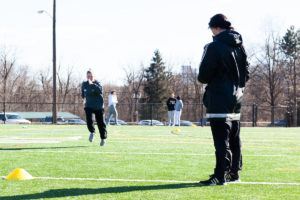
14 Jan The Soccer Community Gets Speed Wrong and Girls Soccer Players are Suffering
I could make a fortune by putting on a show and being like every other “soccer speed guru” on social media.
Alas, I don’t.
As a result of operating in integrity and telling the truth about speed training, I have lost clients along the way. A lot of them.
When parents watch an initial speed assessment with me, they’re scratching their heads and wondering why we are standing around most of the session.
My assessment encompasses a series of movements that require max output from the athlete: jump height, jump distance, jump speed, then acceleration and max velocity sprints that are timed. Then, we rest. A lot. We give the nervous system time to recover.
That it’s. It’s nothing revolutionary. It’s nothing that will go viral on TikTok. It’s nothing that will make soccer parents “ooh” and “ahh.” While the youth player loves my speed sessions because we don’t do busy work that looks like a HIIT circuit, some parents hate my sessions.
So, they bop to the “speed guru” down the road who will put on a show and give the parents what they want, but not what the kid needs.
True Speed Training
You see, I love speed. There’s nothing more liberating than sprinting at max effort, when all of your muscles are firing and your body is flying as fast as possible. Sprinting is the most rewarding and extreme thing an athlete can do.
Here are non-negotiables that must be in every speed session:
Every movement must be less than 6 seconds
Movements must be mechanics, jumps and sprints
Every movement must be max effort
Rest time between movements is long (60 sec between jumps and mechanics, 5 minutes between sprint drills)
Top end speed sprints are over 20 meters in length
All sprints must be timed (I use this speed timing system)
^I have learned from the best in track (Tony Holler, Graham Eaton) because the track folks work with the fastest in the world. They know a thing or two about true speed development, so I’m going to lean in and listen.
If you don’t see a trainer doing these with your soccer player, it’s not speed training. It’s busy work. It’s an aerobic session. It’s all show, and no development. And for the young ones, if sprint drills aren’t turned into fun races and games, also, a red flag.
To be totally honest, you’re better off hiring a track coach than a soccer speed guru you find on social media.
To be totally honest, you're better off hiring a track coach than a soccer speed guru you find on social media. Share on XThe Central Nervous System
The stimulus the body must be given during speed training must be one that fires up the Central Nervous System. Think of the words electric, explosive, springy, twitchy – this is how your young soccer player must be moving during efforts.
There’s so much standing around in a speed session because the Central Nervous System is trained best in short duration, high intensity efforts. Once movements start to go longer than 6 seconds, the body slows down, and muscle contractions become slow due to fatigue.
The speed gurus do longer than 6 second “speed” drills. They toss out a jumble of poles, hurdles, and ladders, and have kids run minutes on end through them. Or, they have them do sprints, but they only rest 90 seconds. Sorry, this isn’t long enough to train the Central Nervous System and get the most out of the player. Speed isn’t conditioning. It’s a separate gear that must be achieved in a separate drill. You can’t be in two gears at once…that’s not how the energy systems work.
Speed isn't conditioning. It's a separate gear that must be achieved in a separate drill. You can't be in two gears at once...that's not how the energy systems work. Share on XSpeed gurus rush development, too. They load kids going through puberty (who already gained ten pounds from muscle and fat mass). It’s a disgrace more load is being added before the building blocks and foundation are laid.
Kids need to master balance, coordination, rhythm, posture and body awareness – a global set of movement skills needed to express speed. Over the years, I’ve found less and less middle schoolers being able to perform a cartwheel and balance on one leg. Yet, people still strap them to a parachute upon initial session.
Basics first. Specifics later.
The pros aren’t exempt from this discussion either. Even at the highest level, the performance coaches feel pressured to look flashy and “soccer specific” to please management. They end up adding the ball to “speed” just to make people happy and stay in a job. I always have wondered why the hamstring strain issue in the pros hasn’t gotten better.
Alas, I digress.
“Shouldn’t the Ball Be in Speed Training?”
There’s no need to get complex. If the goal of the workout is to train top end speed and to raise the ceiling on a player’s MPH number, the ball will be a distraction.
If the goal of the workout is to train top end speed and to raise the ceiling on a player's MPH number, the ball will be a distraction. Share on XFor starters, if the ball is at their feet and they’re dribbling as fast as they can, they’ll only reach 60% of top speed. That is not the best way to train the Central Nervous System. Too, it’s impossible to reach full range of motion sprint mechanics, such as upright posture, knee drive, and ball of foot strike to create vertical force. Having the ball at the feet hinders posture, makes the athlete produce more horizontal force, and slow force.
Another argument I get from the soccer community is, “well can’t you just throw the ball out and have them chase and sprint onto it?” I mean, you could in a separate drill where you’re trying to achieve a different adaptation like reactivity and 1v1 technical skills. But again, if your goal is top MPH, the ball will be a major distraction, the player’s eyes and head won’t be upright enough, which ruins the entire chain of sprint mechanics all down to the foot strike. We need to stop destroying the beauty of max speed training for the sake of being cute. Get your players off the ball because they get enough of it during the training and game week, and start letting them fly and be free.

This doesn’t mean lean toward physical development more than technical and tactical. In fact, I encourage both developed as separate drills. This is where small sided games come into play because they include the conditioning, cognitive and technical load on the player – an excellent bang-for-buck. Want speed dribbling on the ball? A 1v1 and 2v2 on a large pitch does the trick. Want speed off the ball with increased heart rate load and field scanning? Open up the pitch to a 35×30 meter with 6v6, and stay constantly on as a coach. Stoic coaches ruin small sided games, and this causes the high intensity conditioning effect to tank. Be excited and engaged.
Stoic coaches ruin small sided games, and this causes the high intensity conditioning effect to tank. Be excited and engaged. Share on XWith appropriately designed and well-coached small-sided games, supplemented with speed training off the ball, you are developing fast movers and fast thinkers. Or as performance coach Mike Whiteman would say, “apex predators.”
If players are fast off the ball, they will be fast on the ball, but you can’t train it the other way around. There needs to be time for speed training off the ball a few times a week, no longer than 15-20 minute sessions. It’s easy to fit this in, especially if you have stupid fillers in practice like push-ups, burpees and added conditioning. How about you scratch those, and add speed?
Your players will not only get faster, but look forward to training way more. Mind you, their tissues will be able to tolerate stress in the game better because sprint training is one of the best forms of hamstring strengthening.
Speed Training is Simple but Hard
Speed training is simple, but humans always make simplicity hard. This is because they get impatient with the long rest times, and constantly feel like they need to keep kids busy.
“You mean I need to make kids stand around between sets?” I know it seems awkward, and it’s because you’re so indoctrinated by a constantly stimulated culture.
Why don’t you just stop and look at the sunset and enjoy socializing with your players in between sprint efforts? After all, training is not just about getting a player faster, but creating memories of laughter and joy.

Why do you have to make them jog, or juggle a ball during rest time? What’s the point? After all, every effort must be done fresh, and with intensity.
Alas, not many are willing to stick with something this simple. It requires discipline and consistency, and also, going against everything you’ve been taught about soccer speed training.
It requires you to drop your ego, and stop trying to impress the parents.
It requires you to humble yourself, and face bullying from the mob.
It requires you to go against the mainstream, and go down a lonely path.
However, I promise you, if you a blaze the trail with dignity and courage, you’ll find on the other side new, magical ways to serve your youth players. You’ll start to truly build their speed.
It’s worth it.
Enter through the narrow gate.
“Enter through the narrow gate. For wide is the gate and broad is the road that leads to destruction, and many enter through it. But small is the gate and narrow the road that leads to life, and only a few find it.”
Matthew 7:13-14
ABOUT THE AUTHOR

Erica Mulholland is a former college 3x All-American soccer player and now Hall of Famer from Johns Hopkins University. She holds a Master of Science in Exercise Science and has been helping female athletes of all sports with speed, agility, strength, power, and conditioning for over 13 years. She has worked with soccer, lacrosse, track, volleyball, softball, and basketball girls, and has inspired her athletes to strength train not just for sport, but for life.
Her athletes have gone on to play college sports at University of North Carolina, University of Maryland, Pittsburgh, University of Southern California, University of Detroit, Mercy, Northwestern, Eastern Carolina University, Georgetown, West Point, University of South Florida, University of Charleston, MIT, Johns Hopkins, Carnegie Mellon, Rutgers, Towson University, and have gone on to play for professional various clubs in Europe.
Of course, she is proud of her athletes who made it to the college and pro levels, but she is most proud of her girls who stick with being strong and healthy for a lifetime. The training she does is about getting into good habits young, so girls can take these tools with them even after sports end.
Need more personalized help from Erica? BOOK A CONSULT HERE

Interested in Remote Training for Female Athletes? BOOK A CONSULT HERE
Get Erica’s first book THE STRONG FEMALE ATHLETE
Get Erica’s second book FEMALE ATHLETE HIGH PERFORMANCE

Check out her podcast: The Strong Female Athlete


Eddie Vongsiprasom
Posted at 17:10h, 14 JanuaryI love the information! Thank you
erica
Posted at 19:25h, 14 JanuaryYou’re welcome!
Roby Stahl
Posted at 15:00h, 15 JanuaryErica:
Thank you for the well thought article! I’ve been coaching at the pro, collegiate and youth level for over 40 years and you given my more food for thought. Where can I get your book?
erica
Posted at 13:01h, 16 JanuaryTHANK YOU! My book is on Amazon: https://www.amazon.com/Strong-Female-Athlete-Performance-Confidence/dp/B09MYXTPZ9